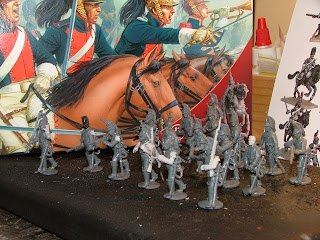Indian Mutiny, 1857: as the last rays of light set a horde of sepoys rushed our lines...
...then began a lively fire upon us from the edge of the ditch
After completing the dismounted French dragoons, before starting the mounted dragoons I had a commission for our Black Powder gaming group for an Indian Mutiny game we're about to have. I had 48 mutinous Sepoys to paint up. As with all my pictures posted on this blog, click on them for the enlarged view.
For those of you visiting this blog who may not be familiar, the Indian Mutiny 1857-58 was the uprising of both Muslim and Hindu native troops (known as 'sepoys') against British rule in India. While the mutiny of Indian troops was not universal it was very widespread, being worse in some areas such as Bengal and the Punjab. The Mutiny (or First Indian War of Liberation if you are an Indian nationalist!) involved some famous sieges such as that at Lucknow near Dehli and months of hard campaigning and fighting. The British were shocked at the scale and ferocity of the rebellion and it took over a year of hard fighting against rebel armies (with a high percentage of British-trained troops!) by the British and loyal native troops before the mutiny was finally suppressed.
Indian Mutiny 1857: the old Subidar urges his men on...
Most of the mutinous Sepoys retained their British uniforms in particular the traditional red jackets. The figures I've painted are Old Glory and while not the most beautifully sculpted figures around, make up for it with the wide range of animated poses and the general accuracy of appearance. I've painted these Sepoys up as Bengali native infantry which being very dark skinned, with simple uniforms made them straight forward but also a challenge to make them look the business. I used a Scorched Brown as the undertone and then a Dark Flesh over to highlight, followed by a Brown Wash to tone. In hindsight I'd use a lighter base colour or just Dark Flesh with the brown wash over for a better effect. While what I achieved may be close to actual appearance - for 28mm figures on a table top you need to exaggerate the tones a bit to make them stand out. I finished them using my own 'Mediterranean' semi-arid mix for the flocking on the bases.

Indian Mutiny 1857: as the sepoys came to the ditch in front of our lines, they hesitated...
...before being urged on for one last charge!
'Allah Akbar!' 'Death to the Infidels!' they shouted as they came on!
All in all I'm happy with the overall result. The flag on the command stand is conjectural - the Bengalis are largely Muslim so I've given them an Islamic green battle flag with 'God is Great' in Arabic script as I couldn't find a suitable reference for 'British Go Home!' written in Bengali!
Mutinous scum they may be, but there is no denying their courage!
It was a nice interlude from painting Napoleonics and hopefully I will have some more pics of the game using these figures to post next week.
Meanwhile, as Homer's mate Apoo says 'Thank you -come again!'
Cheers,
Doc
Thought I'd edit this post just to add a brilliant bit of artwork of one of your actual Bengali Sepoys at the time of the Mutiny. I'd like to attribute it but I do not know who 'WRJ' might be - although it looks like a typical Osprey illustration.
As you can see, there was a large amount of variation in the uniform with many local versions. The usual adaption being the shortening of the jacket and the removal of the collar, which would have been irksome in tropical India to say the least. This lad has substituted a frilly cotton one, as seen on yer more debonair sepoys.
Nice.
Note also the knife tucked into the cummerbund - most 'cutlery' seems to have been worn this way.




































